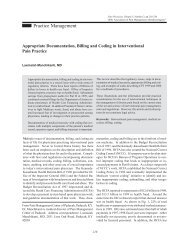ASIPP Practice Guidelines - Pain Physician
ASIPP Practice Guidelines - Pain Physician
ASIPP Practice Guidelines - Pain Physician
You also want an ePaper? Increase the reach of your titles
YUMPU automatically turns print PDFs into web optimized ePapers that Google loves.
Manchikanti et al • <strong>ASIPP</strong> <strong>Practice</strong> <strong>Guidelines</strong><br />
52<br />
discussed as such below.<br />
Caudal Epidural Injections: Extensive literature available<br />
on caudal epidural injections includes six controlled<br />
studies (544-549) and numerous uncontrolled reports (543,<br />
550-559).<br />
Breivik et al (544) in a prospective, randomized, crossover<br />
study, evaluated 35 patients with chronic low back<br />
pain, allocated to treatment with up to three caudal epidural<br />
injections of bupivacaine and methylprednisolone or<br />
bupivacaine and normal saline at weekly intervals. The<br />
study followed a parallel, cohort design and allowed patients<br />
who failed to obtain relief with one of the treatments<br />
to receive the reciprocal treatment. During initial therapy<br />
56% of patients receiving methylprednisolone experienced<br />
significant relief, compared to 26% with bupivacaine with<br />
saline. In the crossover, only one of seven patients who<br />
had methylprednisolone therapy got relief from the subsequent<br />
bupivacaine and saline injection (14%), in contrast<br />
to 73% of patients who failed to respond to bupivacaine<br />
and saline injection reported satisfactory relief after receiving<br />
the methylprednisolone injection. While 50% of<br />
the patients treated with steroids returned to work, 20% of<br />
the patients treated with bupivacaine returned to work.<br />
Bush and Hillier (545) in a double-blind, randomized evaluation<br />
studied 23 patients with lumbar radicular pain allocated<br />
either to receive two caudal epidural injections of<br />
either a 25 mL mixture of normal saline, procaine and 80<br />
mg triamcinolone, or 25 mL of normal saline alone. Patients<br />
were assessed for pain levels, improvement in<br />
straight-leg raise, and lifestyle. The follow-up, at four weeks<br />
demonstrated significantly greater pain relief and mobility<br />
with a significantly improved quality of life following triamcinolone<br />
injection. However, at one year follow-up while<br />
the treated patients showed greater improvement than placebo<br />
patients, the significant difference was limited to<br />
straight-leg raise tolerance.<br />
In contrast to the above studies, Beliveau (547) found no<br />
difference in pain relief between 24 patients treated with<br />
caudal injections of 40 mL of 1% procaine and 80 mg (2<br />
mL) of methylprednisolone, and an equal number of patients<br />
treated with 42 mL of procaine alone. The patients<br />
in this study had moderate or severe unilateral sciatica,<br />
thought to be caused by an intervertebral disc lesion with<br />
or without neurological signs. They assessed the effect of<br />
the injection a week later according to the symptoms and<br />
the findings of physical examination. Injections were repeated<br />
if improvement was seen after the first injection,<br />
with a total of 82 injections for 48 patients. One to three<br />
months later they saw complete relief in 42% of the patients<br />
in the steroid group, and in 29% in the normal saline<br />
group. This study demonstrated the efficacy of caudal<br />
epidural injections in sciatica with or without steroids. It<br />
failed, however, to demonstrate superiority of steroids over<br />
local anesthetic except in cases of long standing severe<br />
sciatica.<br />
Yates (549) treated patients with low back pain and sciatica<br />
by epidural injection of normal saline or 0.5% lignocaine,<br />
with or without triamcinolone given at weekly<br />
intervals in random order. Subjective and objective criteria<br />
of progress were measured. Greatest improvement was<br />
noted after the injection containing steroid. Lignocaine<br />
0.5%, and normal saline used individually produced less<br />
marked improvement. No specific benefits of local anesthesia<br />
were found other than comfort during injection. His<br />
report did not address pain relief but focused on improvement<br />
in straight leg raising, which seemed to correlate with<br />
pain relief.<br />
Matthews et al (546) compared the responses of patients<br />
treated with caudal epidural injections of bupivacaine and<br />
methylprednisolone or a control injection of 2 mL of lignocaine<br />
over the sacral hiatus. At assessment after one<br />
month, there was no significant difference between the two<br />
groups. However, at three months, the treated group was<br />
reported to be significantly more pain free.<br />
Czarski (547) evaluated the use of caudal epidural injections<br />
comparing novocaine and hydrocortisone and<br />
procaine hydrochloride alone in the treatment of patients<br />
with prolapsed lumbar intervertebral disc, with 60 patients<br />
in procaine hydrochloride group and 123 patients in<br />
procaine hydrochloride and hydrocortisone group. He<br />
demonstrated statistically significant and clinically significant<br />
differences in outcomes comparing the use of caudal<br />
epidural injections. Unfortunately, however, the duration<br />
of follow-up was not specified even though complete relief<br />
was reported in 22 of the 123 patients, with significant<br />
relief in 64 of 123 patients; whereas marginal relief was<br />
reported in 14 patients with no relief or patients getting<br />
worse on 23 occasions in hydrocortisone group. In comparison,<br />
in procaine hydrochloride group, 8 of 60 patients<br />
obtained significant relief, none of the patients obtaining<br />
complete relief, 35 obtaining marginal relief and 17 patients<br />
getting no relief or becoming worse.<br />
Numerous uncontrolled reports on the use of caudal epi-<br />
<strong>Pain</strong> <strong>Physician</strong> Vol. 4, No. 1, 2001
















